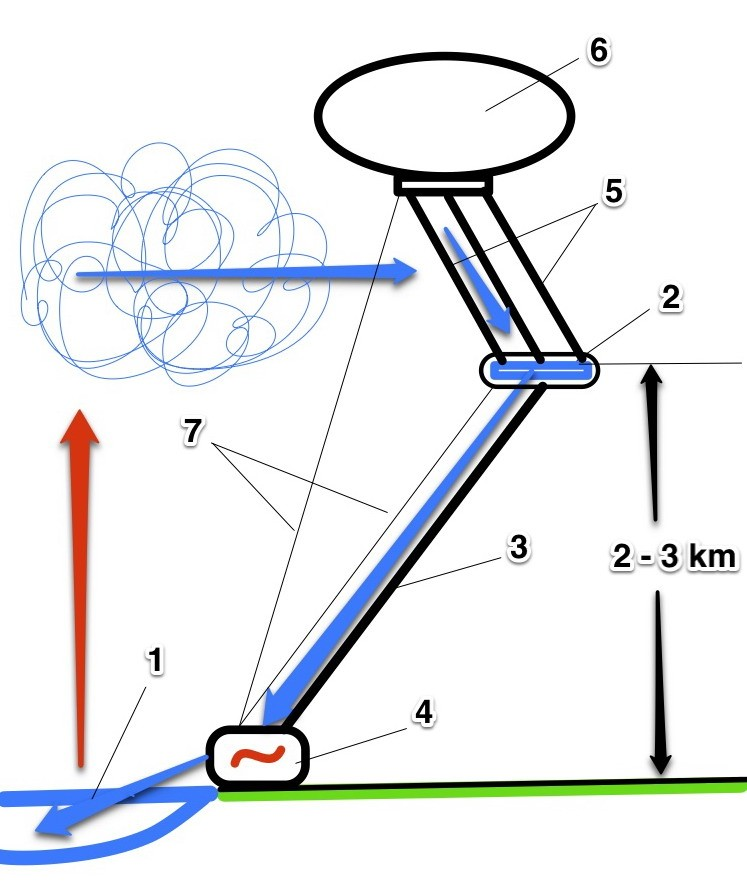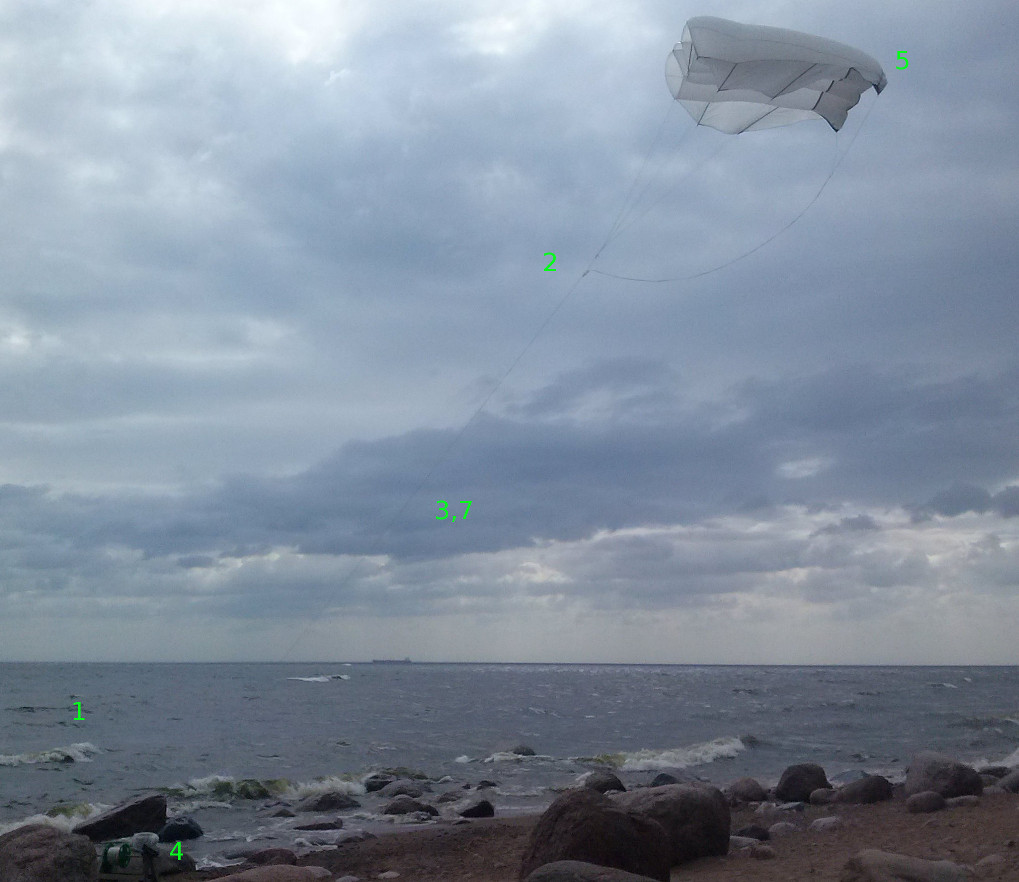Air HES stands for air hydroelectric station.
How to implement a solution – AirHES – Air Hydro Power
The scheme of one of the solutions is shown in Fig. AirHES provides a downstream (water’s outflow) 1, upstream (water’s inflow) 2, conduit (pipe, penstock) 3, the turbo generator 4, mesh, fabric or film surfaces 5, airship (air-balloon) 6, and the fastening ropes (tethers, lines) 7.
The airship 6 lifts the surfaces 5 at the height of near or above the dew point (condensation level by ARL sounding, base of clouds) for current atmospheric conditions (typically 2-3 km). There supercooled atmospheric moisture begins to condense (or collect LWC from clouds) on the surfaces 5. The drainage system on the surfaces 5 assigns the water in a small reservoir (upstream 2), where water under pressure from whole hydraulic head (2-3 km) flows through the penstock or conduit 3 to the downstream 1 on the ground, producing electricity in the turbo generator 4.
The AirHES can be easily mounted in any convenient place for the consumer of electricity and water, simply by lifting and moving it entirely by using the same airship 6.
If at this point the winds are blowing steady permanent or it is a portable unit (for example, for tourists or military), you can do without the airship 6 and use surfaces 5 like the paragliding wing for self-containment of the assembly in the air (as occurs when you run a kite).
Also, the surfaces 5 can be performed with full or partial metallization (for example, by weaving metal wire). This will increase the structural strength, reduce solar heat, to increase the condensation of water vapor through the filing of an electric field (for example, have experimented with this corona discharge), as well as the need to reduce the ice due to current supply.
Generally, icing can be used as the standard mode, since the system has automatic resistance – with the accumulation of ice the whole structure will fall in the region of higher temperature of the atmosphere, and after the melting of the ice itself will rise to the desired height.
Since AirHES (as well as any other renewable energy) depends on the weather, the best way is to use of combinable system. Obvious that the balloon in the shape of almost flat glider makes it easy to place on the upper surface of the solar panels that will actively work just in the absence of clouds. At the same time you can use and the significant wind speed at such height by applying as a fastener a distributed cross-flow turbine under the patent CA 1041872. This will solve simultaneously the problem with delivery of water and energy without using pressure or gravity pipe. Thus, the system will be almost independent of weather conditions.
In addition to direct energy storage in the form of water supply upstream (similar to that performed on any Hydropower) AirHP can easily be modified to increase its storage capacity is about 600 times! It’s enough to add hydrogen hose and to use ballonet aerostat, which in this case will not only ensure the maintenance AirHP elements, but also to keep a stock of hydrogen as an energy storage agent. It is easy to show that 1 kg of hydrogen (with a calorific value 120.9 MJ/kg) holds in the upper reach of about 10 kg of water with a supply of hydropower only 0.2 MJ. So on AirHP during overproduction of energy can always be by pumping hydrogen (produced by electrolysis at the bottom) and balanced drain to provide the necessary amount of water in the upper reach (to maintain steady-state design and minimize the tension holding the ropes) and magnified 600 times the amount of energy which, if necessary energy, can always be balanced so as to get back in the fuel cells (from hydrogen) and a turbogenerator (from water). By the way, you can still pick up on it and transporting hydrogen itself as a fuel in these airships, dirigibles transport such loads, etc.
Also, as you know, one of the main problems for renewables is their irregularity (meteo dependence), and hence the need for further significant investments in energy storage. One of the best solutions for today of this task is a pumped-storage plant (PSP). By using a suitable hill, you can build a reversible hydroelectric power plant, which operates either the pump mode, or the regenerative mode. At the same time the efficiency of reversible hydroelectric units are generally much worse than conventional water turbines.
AirHES of cascade type can elegantly solve this problem, and at the same time solve the problem of the meteo dependence. If there is a suitable hill, but there is no a river, the AirHES can easily create this artificial “river” and the intermediate upstream by draining its water in natural (meteo dependent) mode NOT to the downstream, BUT to this intermediate upstream of the cascade hydropower plant. Then the lower hydroelectric power station and will play the role of accumulator (PSP) with usual hydraulic turbines, and coordinated work of the AirHES and this cascade conventional HPP will completely eliminate a meteo dependence. The pump mode in this case can be eliminated - Sun will operate itself as the pump by lifting the water up to the clouds.
How it works
In terms of electricity generation it works the same way as in conventional hydropower, but the conventional HPS has a general principle drawbacks: they require significant capital expenditures for the construction of dams, occupy large areas under the reservoir, causing damage to the environment and are usually far from the consumer. In addition, there is always a potential danger of possible collapse of the dam. To a certain extent, these shortcomings are a consequence of the relatively small hydraulic heads with the huge volumes of water, typical for the majority of lowland rivers.
Nevertheless, the heads of 2 km, like in AirHES, are not extraordinary. There are some plants (Bieudron Swiss HPS) that work with these heads and using a simple turbine, invented in 1889 by an American engineer Allan Pelton.
The principal difference AirHES is the condensation of moisture from the air that at first glance it seems funny and impractical curiosity. Nevertheless, there is nothing unusual. In the world there are several great working systems, known as fog collectors. For example, a device for collecting drinking water in Chile was tested in 1987 and is well described with all specifications.
Indeed the “cloud collector” would work like a “fog collector”
A similar device but using a wind turbine and without the hydro power function is presented by Hidalgo Quinto in a comment where I evoked a possibility (?) for AWES.
A part of this system takes the technology of a dehumidifier. As there are many options, specific studies of a suitable AWE system could be done. If electricity is needed aloft, then the turbines on the kite could produce it without requiring it to be routed to the ground.
I haven’t yet studied enough what could be a flying fog collector to have an opinion.



 Andrew Kazantsev
Andrew Kazantsev